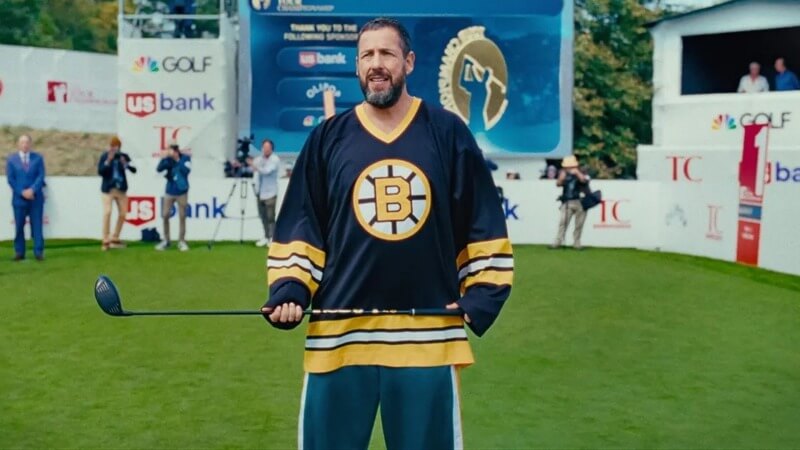Fleetingly Funny Happy Gilmore 2 Shanks its Repetitive Comedy

If ever a feature film has not needed to be two hours long, then surely that film is a 29 years belated sequel to Happy Gilmore. The follow-up to 1996’s classic Adam Sandler hockey-player-turned-pro-golfer farce stars a now 58-year-old Sandler as the title character, along with not only every (surviving) performer who occupied even a second of celluloid in the original, but also every actor or sports star with whom Sandler has interacted with at any point in the last three decades. Occasionally funny in spite of itself, particularly when relying on tried and true slapstick zaniness and the admittedly irresistible performance of Christopher McDonald as Shooter McGavin, it steadily becomes a punishing endurance run that belabors the same handful of gags to the point of nausea. Happy Gilmore 2 ends up trying to loft itself out of an impossibly deep sand trap of its own devising.
First things first: We need a reason for the world famous, decorated PGA champion Happy Gilmore to be forced out of retirement, which means our premise requires a fall from grace. This it accomplishes with unexpected brutality in its opening moments, so I won’t consider it a spoiler: Happy’s life is upended when one of his own errant drives kills his wife Virginia (poor Julie Bowen!) on the golf course, thrusting him into single, widower fatherhood, raising four sons and a daughter. Before long, the tempestuous Happy has lost everything, reduced to a middle-aged sad sack working at a local grocery store, nursing an out-of-control alcohol addiction that is consistently played for laughs rather than as a dire health crisis. He’s mostly content to look back on his faded dreams of ‘90s glory and live vicariously through his oafish squad of equally hot-headed idiot sons, and much more talented ballet dancer daughter Vienna … played by Sandler’s own 16-year-old daughter Sunny, with Happy Gilmore 2 clearly devised as a nepotistic launchpad for her career. But when Vienna is accepted to a prestigious Paris ballet school, the only way Happy can scrounge up the necessary cash is to return to the professional golf world in search of a few more paydays and rekindled esteem.
That would be a perfectly serviceable outline for a bog standard legacy sequel to Happy Gilmore, but the film, written by Sandler and longtime collaborator Tim Herlihy, ultimately takes us on a significantly stranger and more bloated odyssey. Happy’s return to the professional golf world is complicated by that world also being thrown into flux by the arrival of the “Maxi Golf” tour (an obvious LIV Golf parody), a brash and unconventional attempt to modernize the “boring” sport with loud, colorful obnoxiousness and gimmickry. This thrusts the one-time disruptor Gilmore into the new role of a protector of tradition, mirroring perhaps the way that Sandler himself went from a foul-mouthed SNL button pusher and provoker to a Netflix house brand churning out warmed-over streaming pablum, with the occasional dalliance into actual dramatic work ‘a la Uncut Gems–amusingly, director Benny Safdie returns the favor by portraying the villain here. It also has the genuinely unexpected side effect of putting Happy Gilmore in the same ideological boat as Shooter McGavin, whose insistence on the sanctity of the sport (his main beef with Gilmore in the original film) logically means that he would likewise detest Maxi Golf.
Shooter, perhaps unsurprisingly, is the highlight of Happy Gilmore 2 whenever he’s on screen, as Christopher McDonald has not lost a beat in depicting the charismatic, shit-eating egotist who likewise had most of the original’s best lines. The film really leans into its more absurd side in its reveal that McGavin has spent the last 29 years in a mental institution after being “found not guilty by reason of insanity” when he went on a rampage following the attempted theft of Happy’s gold PGA Tour jacket. When we meet him, he’s clearly nursing the most poorly hidden grudge since Sideshow Bob’s DIE BART DIE tattoo, which makes an eventual showdown with Happy a necessity. In the grand tradition of anime in which a defeated villain then becomes part of the protagonist crew, however, Shooter is eventually an ally in arms in defending the soul of what the film constantly refers to as “regular golf,” against the villainous, Dodgeball-esque Maxi Golf crew. Unfortunately, as in the same anime trope, this also reduces Shooter to an underused background player at the end of the day.